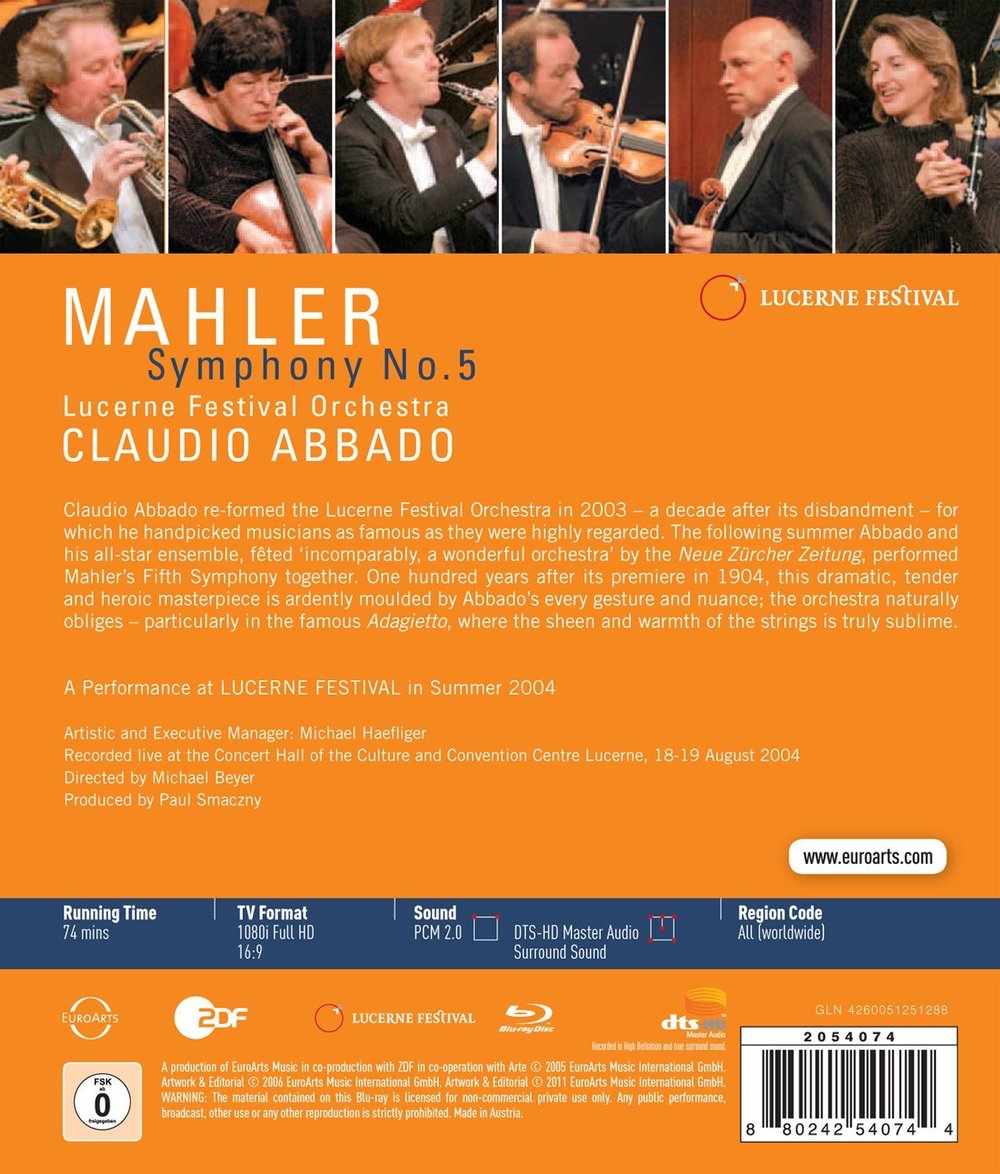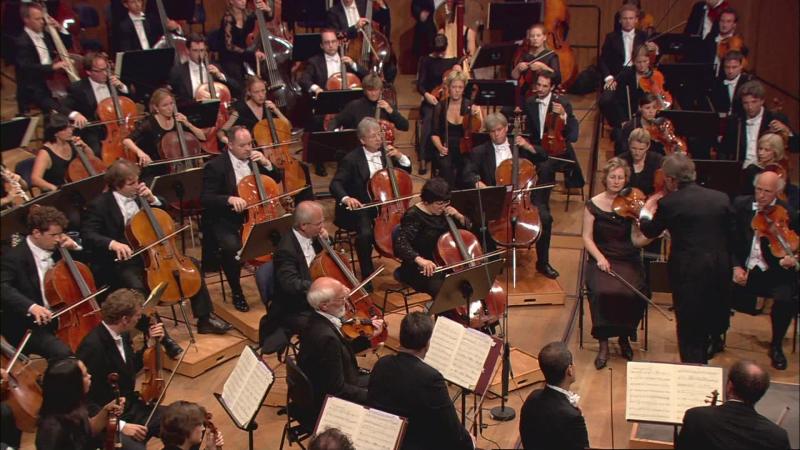

Mahler Symphony No. 5. Claudio Abbado conducts the Lucerne Festival Orchestra at the KKL Luzern in 2004. Directed for TV by Michael Beyer; produced by Paul Smaczny. Released 2011, disc has 5.1 dts-HD Master Audio sound. Grade: D
When this concert was recorded in 2004, everyone knew that HD TV was coming, but the details were probably sketchy and HD recording gear was probably expensive and hard to find. The KKL Lucern Hall was well-known to videographers. But I imagine that shooting at a summer festival is always stressful; and for this event, the stage was completely full of musicians. Beyer's recording came out in DVD in 2005. After another 6 years, it was published in Blu-ray in 2011.
I warned readers that the video content of this recording was probably infected with DVDitis. I just ran the numbers, and I now report it's worse than that: the video content here is a corpse. There are 68 minutes of music divided into 754 video clips (includes perhaps 10 panned clips that I counted as a total of 20 clips). This yields the too rapid pace of 5.4 seconds per clip.
Here's the clip breakdown:
Conductor shots = 199
Conductor-over-backs (C/B) shots = 62
Solo and other small-scale clips = 361
*Large-scale clips = 40
*Part-orchestra clips = 16
*Whole-orchestra clips = 19
Instrument-only clips = 56
Other low-value shots = 1 (orchestra looks like an anthill)
There are 75 "supershots" (add up the * numbers above of 40+16+19). So the supershots are only 10% of the total clips. Conductor shots total 261 (199+62), and conductor shots gobble up 35% of the film (261/764).
HDVDarts.com has established the following rules-of-thumb to identify a Blu-ray with DVDitis:
“A good symphony HDVD should have a slow pace with more than 10 seconds per video clip on average. 20 to 40% of the clips should be large-scale "supershots." Conductor shots should be less than 20% of the clips in the video.”
Subject title fails miserably on all three tests. These are some of the worse video-content numbers I can remember for a symphony Blu-ray.
Time for some screenshots. The first shot below is a typical whole-orchestra view Beyer used several times. Even when the camera moves a bit closer, the resolution is too soft to be considered a useful image:
Beyer did have the ability to make nice part-orchestra shots. Sadly, there are only 16 of these in the whole video. Here's a good look at the violins:
And next below is a neat shot of part of the violins playing pizzicato:
Even though the shot below is too soft, it does a good job of showing all 14 cellos:
This next similar part-orchestra shot gets in the double basses (sort of). But because the angle is so low, the rest of the picture is hampered by the backs of players:
Next below is a handsome view of violas. Note how close together the musicians are seated. There is an important harp part in this symphony. And you can also hear the harp quite well throughout the recording. But the harpist is tightly surrounded by so many strings that there was no way to frame her with a camera. The best Beyer can do is a bunch of low-value shots of harp strings being plucked by a pair of hands:
Below is the only decent shot in the video of the brass row:
There are 361 clips of solos and small groups. I shouldn't exhaust your patience with many of these shots. But next below is my favorite:
And here's a similar shot of a different horn player. When this shot appears on the screen, your attention goes, of course, to the mouthpiece of the horn where the musician is sputtering away (doing a masterful job of controlling this most balky of instruments). While you focus on his mouth, the rest of the image is in peripheral vision. Peripheral vision is fuzzy, but it is also exquisitely sensitive to motion. So while watching this view, your attention will be drawn to something happening on the right. When you change your point of attention, you will note a fat bead of saliva running down the flair of the horn below the performer's right hand. All brass instruments create rivers of spit that can get messy as they start their trek to the ocean:
With 261 conductor shots in 68 minutes, one would not be too surprised if a ménage à trois event turns up. A ménage à trois occurs in a symphony when there are 3 conductor shots in a row that combine at least one regular conductor view with at least one conductor-over-backs shot (i.e. typically, a C-C/B-C sequence). Well, at 00:07:22 we get the beginning of such an event with the image below:
The next clip at 00:07:32 is a C/B shot:
And the next clip is, you guessed it, a trip back to an individual conductor in the shot at 00:07:39 shown below. I can't image why any TV director would want to do anything this inane. One logical explanation would be that nobody noticed or thought it odd. But I must be wrong about this. There must be some good reason that I'm missing. This occurs to me because there are 3 more ménage à trois events that pop up later in this video! [See 00:25:09, 01:03:05, and 1:08:45 to check my facts.]
Another deadly video sin is a long pan like the one seen below. It paints the whole orchestra as a continuous motion blur from start to finish. Maybe I'm missing something again. The picture below does look something like one of those strange altered photos that Gerhard Richter produces and sells for big bucks:
On this website, instrument-only shots are always under attack as lazy filler used by the TV director when he runs out of better ideas. But there are exceptions when an instrument-only shot can be useful in making a special point. For example, the 1st Movement of this symphony ends with a single pizzicato note played by all the lower strings at pp. But Beyer didn't have a good way to show all the lower strings doing anything. In the image below you see a hand getting ready to make a pluck on a single instrument—this caught me off guard and was an effective way to depict visually the rich, concluding pizzicato that I heard:
But there are another 55 instrument-only views that are mostly junk shots like the image below with everything out-of-focus except the bell and inner slide of one trombone:
I hope I've given you fair warning about the poor video content here. Still, all is not lost. This was an exciting performance of extremely dramatic and interesting music by an excellent orchestra under a great conductor. The SQ is excellent. Even a mediocre video recording can be worthwhile when compared to just listening to a CD. Our mission here is not to fret too much about the past. Looking to the future, we advocate for great performances matched with excellent PQ and video content that takes full advantage of HD TV.
Before we can agitate for change, we have to show our reasons for being unhappy with the current state of things. And you might wonder how I know there are 754 clips in this video. Well, I used the Wonk Worksheet which you can read here.
Now for a grade. For soft PQ I deduct a letter grade. A terminal case of DVDitis earns a further deduction of 2 grades. Considering all the instrument-only shots, focus errors, and excessive panning, I see an F looming up. But the excellent SQ causes me to relent and arrive at a D. Under our grading system, this means don't buy this unless you have a really good reason.
OR















